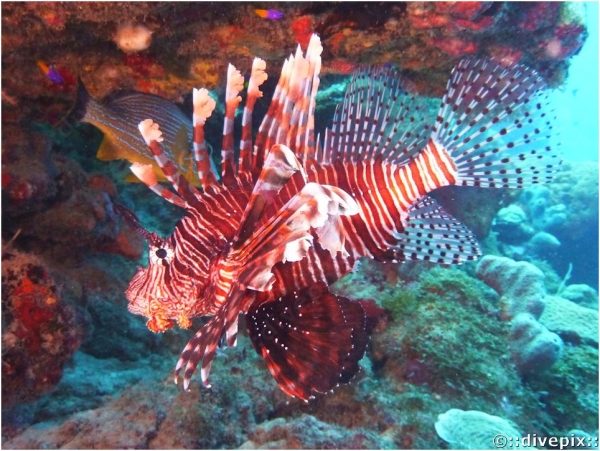| Aspect: | From dark maroon through red to light brown (depending on sexual activity) with irregular white vertical bars. All fins are mottled white/body colour and look like wing feathers (hence volitans, or flying in Latin). Reproduction is phenomenal: a female spawns some 15,000 eggs that are immediately fertilised by the male, with larvae hatching after only 36 hours to become capable swimmers days later. Has very few predators. |
| Population: | Originally an Asian area species and unknown to the mid- and south-Caribbean sea until 2010 when it started to spread like a plague following, it is alledged, the rupture of a Florida aquarium caused by Hurricane Andrew in 1992. Rare in 2010 around Ilets Pigeon, ubiquitous two years later. |
| Notable feature: | Dorsal, anal and pelvic spines are venomous. Close-up pictures taken here show that there is no real element to substantiate claims of diiferent species to minimise the responsibility of the Miami aquarium debacle. Eyebrow growth, colour differences and number of poisonous dorsal fins (photos shown here reveal between eleven and twelve) appear to pertain to age and stress. |
| Environment: | Anywhere day and night (though it hunts at night) around the reef, up to five or six can be found at a time under a rock overhang. |
| Behaviour: | Can be approached, with usual precautions, but has a habit of turning round to show its back, probably to present its very harmful (can eventually cause gangrene) dorsal and pelvic spines. Although the latin word volitans means "flying" or "hovering" to reflect the animal's wing-like fins the Pterois Volitans does not fly, contrary to what the French designation Rascasse Volante may suggest. |





Red Lionfish
- Désignation anglaise: Rascasse Volante ou Poisson Lion
- Désignation latine: Pterois Volitans
- Désignation créole: -
- Famille en latin: scorpaenidae
- Taille (cm): 30-45
View the embedded image gallery online at:
https://divepix.webdhb.com/index.php/fr/animalia/fish/odd-shaped-benthic/lionfishes/97#sigProId8ab086850c
https://divepix.webdhb.com/index.php/fr/animalia/fish/odd-shaped-benthic/lionfishes/97#sigProId8ab086850c




